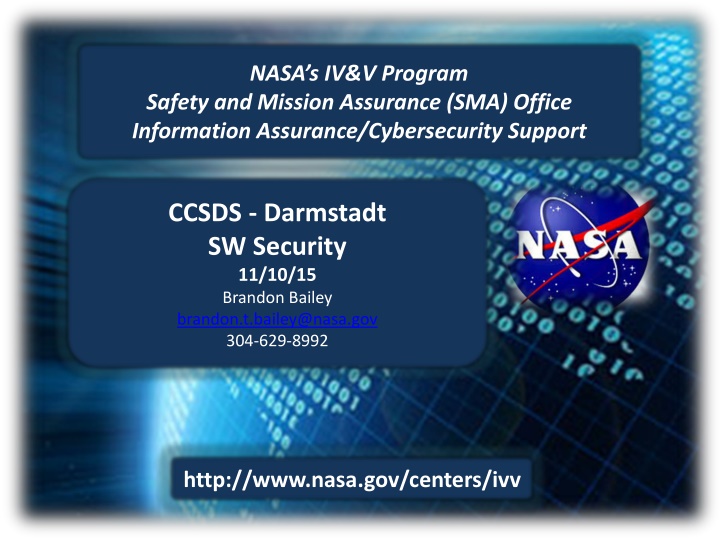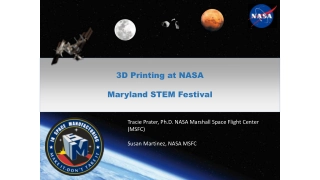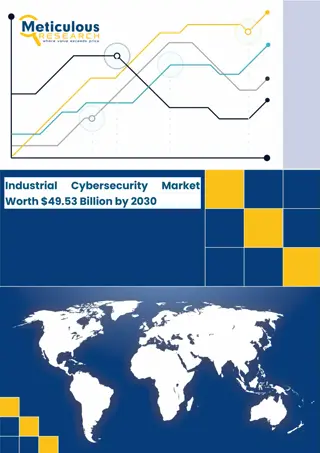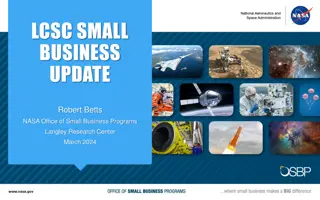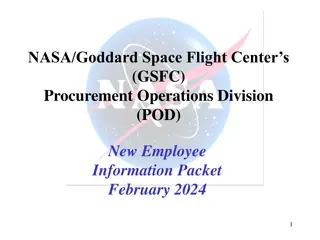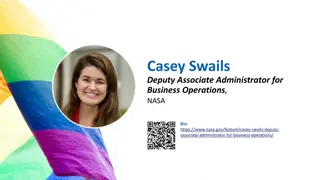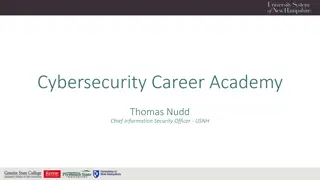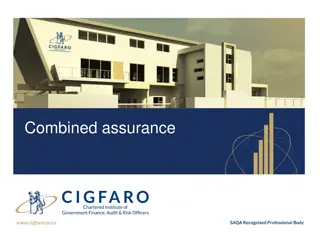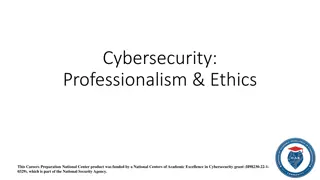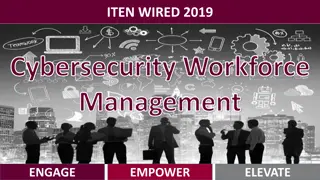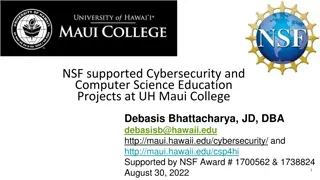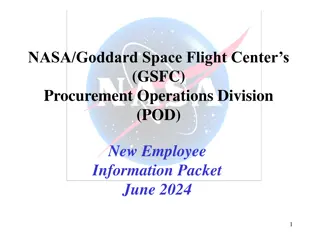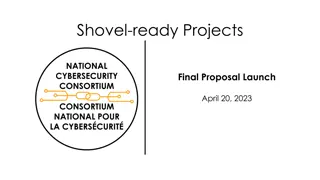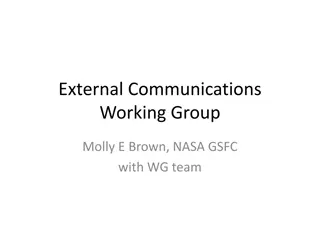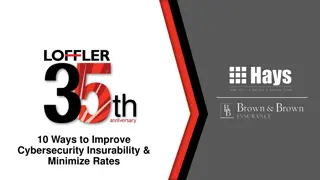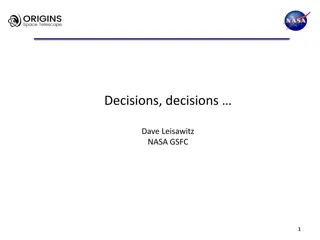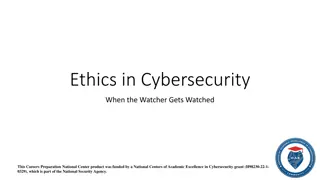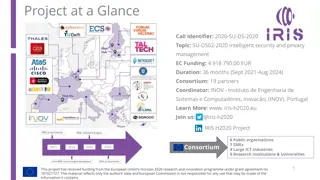Enhancing NASA's Cybersecurity for Mission Assurance
NASA's IV&V Program Safety and Mission Assurance Office prioritizes cybersecurity to protect mission assets. The evolving threat landscape necessitates a robust security posture, focusing on network security, software vulnerabilities, and secure development practices. Measures include leveraging secure coding standards, integrating code analyzers, and updating security standards to assure software security. Training and awareness play a crucial role in enhancing NASA's cybersecurity resilience.
Download Presentation

Please find below an Image/Link to download the presentation.
The content on the website is provided AS IS for your information and personal use only. It may not be sold, licensed, or shared on other websites without obtaining consent from the author.If you encounter any issues during the download, it is possible that the publisher has removed the file from their server.
You are allowed to download the files provided on this website for personal or commercial use, subject to the condition that they are used lawfully. All files are the property of their respective owners.
The content on the website is provided AS IS for your information and personal use only. It may not be sold, licensed, or shared on other websites without obtaining consent from the author.
E N D
Presentation Transcript
NASAs IV&V Program Safety and Mission Assurance (SMA) Office Information Assurance/Cybersecurity Support CCSDS - Darmstadt SW Security 11/10/15 Brandon Bailey brandon.t.bailey@nasa.gov 304-629-8992 http://www.nasa.gov/centers/ivv
http://inside.nasa.gov/ocio/sites/inside.nasa.gov.ocio/files/nasa-logo.pnghttp://inside.nasa.gov/ocio/sites/inside.nasa.gov.ocio/files/nasa-logo.png IV&V Cyber Introduction NASA s Mission is to put things into space and the air and the security posture of mission assets MUST be a priority Historically security within NASA was thought of as an IT function (web sites/servers, email, workstation patching, etc.) Threat landscape has shifted and NASA is a TARGET of various threat actors (Script Kiddies, Hackers, Advanced Persistent Threat (APT), Nation States, etc.) Attack surface has expanded Networks interconnected!! Some security posture factors Network Layer (Routers, Firewalls, etc.) Computer Network Defense (IPS/IDS, Sensors, Continuous Monitoring, etc.) Industrial Control Systems (ICS) Software Security (COTS, FOSS, Custom, etc.) 2
http://inside.nasa.gov/ocio/sites/inside.nasa.gov.ocio/files/nasa-logo.pnghttp://inside.nasa.gov/ocio/sites/inside.nasa.gov.ocio/files/nasa-logo.png IV&V Cyber Reducing the SW Risk NASA knows that software is one of many vulnerabilities that could adversely impact Mission Operations Levying requirements from the top (NPR 2810 , 7150.2B) Software vulnerabilities or defects are arguably preventable in most cases During custom code development Secure Development Rigorous SwA (Project and IV&V) Awareness, Training, Tooling (i.e. SCP) Software supply chain COTS and Open Source (i.e. Origin Analysis) Once introduced in operation then what? Penetration Testing Vulnerability Assessments 3
http://inside.nasa.gov/ocio/sites/inside.nasa.gov.ocio/files/nasa-logo.pnghttp://inside.nasa.gov/ocio/sites/inside.nasa.gov.ocio/files/nasa-logo.png IV&V Cyber Secure Development Utilize Best Practices some examples below Coding Standards (Ex. CERT C, C++ or JAVA Stds) Integrate tools into development environment Code Analyzers (i.e. Klockwork, Fortify, CodeSonar, Sonatype, BlackDuck, etc.) Defense in Depth Training Secure Coding Tutorial Defensive Programming (search in SATERN) Codiscope 4
http://inside.nasa.gov/ocio/sites/inside.nasa.gov.ocio/files/nasa-logo.pnghttp://inside.nasa.gov/ocio/sites/inside.nasa.gov.ocio/files/nasa-logo.png IV&V Cyber SwA Assuring Security Update SwA Standard and Handbook (in work) Provide awareness/training to SwA personnel Educate on importance of SW security (this briefing is a start!) SwA personnel can leverage the same training as developers (i.e. SCP) In order to assure it, you must understand it! Utilize information on Secure Coding Portal (more to come on this!) Not a clipboard exercise SwA needs to use tools or ensure tools are being used to ensure SW is secure Tools have latest security signatures and integrate industry s best practices Dynamic & static code analysis as well as binary analysis (i.e. identifying CWEs/CVEs) Verify and validate project is accounting for security during requirements, testing, etc. Ex: Security Requirement Traceability Matrix (SRTM), Whitebox/Blackbox Testing, Negative Testing, PenTesting, etc. 5
http://inside.nasa.gov/ocio/sites/inside.nasa.gov.ocio/files/nasa-logo.pnghttp://inside.nasa.gov/ocio/sites/inside.nasa.gov.ocio/files/nasa-logo.png Secure Coding Portal (SCP) Background IV&V Cyber Recognizing the need to counteract the threat of exploitation of custom developed software A single touch point for NASA developers was established to learn how to develop code securely Utilizes existing NASA Engineering Network (NEN) infrastructure Initial deployment is behind NASA firewall Partnerships established with experts CMU-SEI Robert Seacord (Author of CERT C Std.) Safari Books Online (custom secure coding tutorial) Launched July 20, 2015 Volume One of Newsletter Distributed Custom Secure Coding Tutorial Deployed Contact securecodingportal@lists.nasa.gov for additional information https://nen.nasa.gov/web/coding 6
http://inside.nasa.gov/ocio/sites/inside.nasa.gov.ocio/files/nasa-logo.pnghttp://inside.nasa.gov/ocio/sites/inside.nasa.gov.ocio/files/nasa-logo.png IV&V Cyber Secure Coding Portal Content Secure Coding Discussion Forum providing a friendly environment to discuss all aspects of Secure Coding with fellow engineers and experts Vulnerability Updates containing information about the latest software vulnerabilities and any insight into what systems, or types of systems, could be affected along with how to detect and mitigate these vulnerabilities Vulnerability Newsletter will also be distributed directly to stakeholders Tools containing information about tools utilized by NASA for security analysis of software, including references, available training, and any relative insight/lessons learned from NASA practitioners Links containing references to security standards, documentation, and information Top 25 CWEs using CWSS to classify Top 25 CWEs for ground and flight Tutorial custom made tutorial by secure coding experts Ask an Expert providing the ability for any community member to request assistance from field experts 7
http://inside.nasa.gov/ocio/sites/inside.nasa.gov.ocio/files/nasa-logo.pnghttp://inside.nasa.gov/ocio/sites/inside.nasa.gov.ocio/files/nasa-logo.png IV&V Cyber SCP Future Work Continue to develop newsletters Vulnerability research across IV&V project to see what common vulnerabilities are being made Providing a list of vulnerabilities that resides in commonly used third party software (COTS/FOSS ) Making the information available to decision makers so they can make Risk Informed Decisions Offer Free Open Source Vulnerability Scanning to agency Use IV&V s toolset (BlackDuck, Sonatype, and OWASP Dependency Check) to run project s binaries and source code Perform additional research on Mitre s CWE list to ensure our categorization of Flight and Ground CWEs are current/correct If desired we can use the database tool we created to generate CWE lists for Web Apps, Deep Space, Low Earth, etc. Videos for SCP Video tours of SCP Webinars for SCP Training videos of setting up tools, using tools, etc. that are recommended on Tools Page Build off work being funded by OSMA for hosting code security tools in the cloud more tools, more VMs etc. Infuse feedback from user communities (SwA WG, SWG, etc.) Map NIST controls to mission software and/or 7150.2B and 2810 Will help tie software being developed and hosted on accredited systems to appropriate NIST controls Translate the guidance from NIST for supply chain down to the mission developer level 8
http://inside.nasa.gov/ocio/sites/inside.nasa.gov.ocio/files/nasa-logo.pnghttp://inside.nasa.gov/ocio/sites/inside.nasa.gov.ocio/files/nasa-logo.png IV&V Cyber Origin Analysis From Institute for Defense Analyses (IDA) SOAR Report Origin analyzers are tools that analyze source code, bytecode, or binary code to determine their origins (e.g., pedigree and version). NASA is beginning to invest in Origin Analysis to reduce the software supply chain risk Initial roll out was/is during vulnerability assessments (i.e. BT-VAP) Next step is to provide scanning as a service as a part of the Secure Coding Portal performed by SCP team Ultimate goal is to deploy origin analysis tools to NASA cloud for consumption by development organizations Tools being used Sonatype (auditor version) Black Duck HUB Note: Newer product similar but different from Black Duck Suite OWASP Dependency Check Work being performed to automate and consolidate report creation from all three tools 9
Recommendations for NASA Missions http://inside.nasa.gov/ocio/sites/inside.nasa.gov.ocio/files/nasa-logo.png IV&V Cyber To prevent future deployments of vulnerable code Developers and SwA personnel participate in secure code training Institute static source code and binary analysis to assist in identifying weaknesses (i.e. Developers, SwA, or IV&V) Developers should perform software evaluations throughout the software development lifecycle to address potential security vulnerabilities early in the process SwA should assure this is happening! Factor of 10 in cost savings finding issues early Use research from NSA s CAS and Institute for Defense Analyses to establish a blend of tools that will provide the most value Spreadsheet - http://www.acq.osd.mil/se/docs/P-5061-AppendixE-soar-sw-matrix- v9-mobility.xlsx 10
http://inside.nasa.gov/ocio/sites/inside.nasa.gov.ocio/files/nasa-logo.pnghttp://inside.nasa.gov/ocio/sites/inside.nasa.gov.ocio/files/nasa-logo.png IV&V Cyber BACKUP SLIDES 11
Developers must securely code to ensure the Technical Controls maintain the system s security posture. securely code to implement the Security Controls identified in the SSP securely code to NASA- specific requirements, procedures and recommendations that augment NIST guidance. ITS-HBK 2810.14-01 System and Information Integrity ITS-HBK 2810.15-1A Access Control ITS-HBK 2810.15-2A Access Control: Managed Elevated Privileges (EP) ITS-HBK 2810.16-01 Audit and Accountability ITS-HBK 2810.17-01 Identification and Authentication ITS-HBK 2810.18-01 System and Communications Protection Back
Developers must securely code to mitigate software security defects. adhere to the plans to mitigate security risks. implement risk mitigations in software to enable mission security. responsibly evaluate and consciously mitigate the risks of using sourced software. securely code to address all Use Cases when establishing access controls. use Static Code Analysis. have software V&V d. Back 13
may need a clearance to review certain docs. Long lead time!! DRAFT Requirements SSP won t segregate software from system. Focus on controls that affect SW compliance to their own security plan. Assure SW Supply Chain! Not Final!!! SW security risks/mitigations are identified in PPP assure security requirements are identified and followed through implementation SW security isn t a snapshot in time. Threats/Vulnerabilities are evolving and must be continually mitigated << see next slide >> 14 assure HW supply chain
SA must assure secure SW development practices are being followed assure their PPP identifies and mitigates SW security risks. assure the implementation of the risk mitigations in SW assure SW supply chain. Use tools when possible! assure SW addresses all Use Cases when establishing access controls. assure Static Code Analysis is performed -- best way to identify vulnerability in code assure they are V&Ving their risk implementations Back 15
